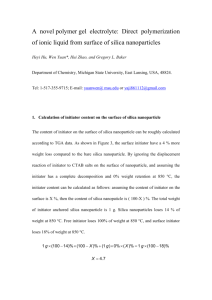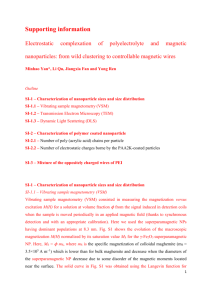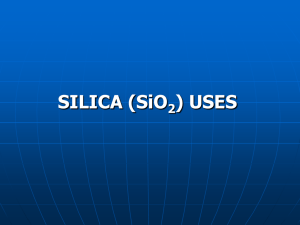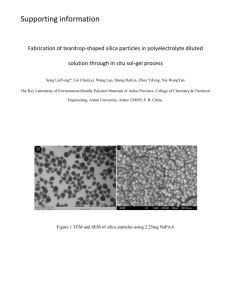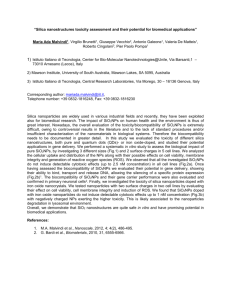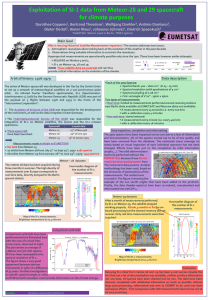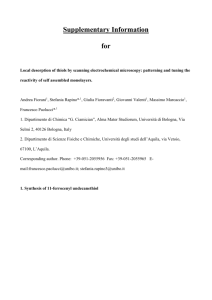pola27785-sup-0001-suppinfo01
advertisement
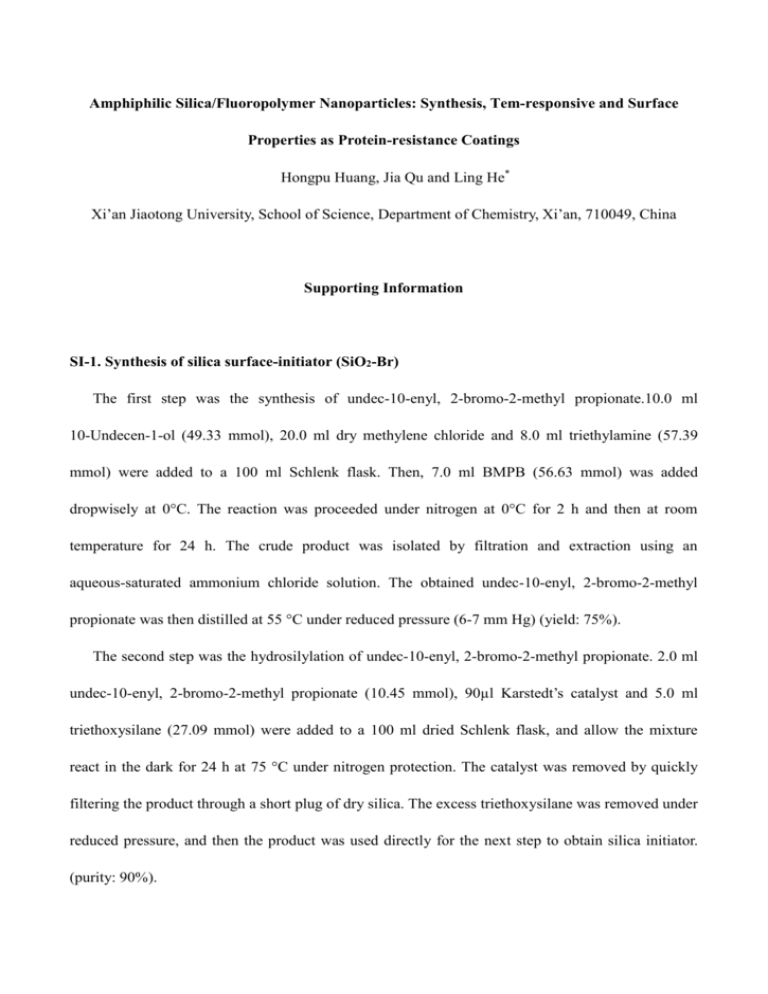
Amphiphilic Silica/Fluoropolymer Nanoparticles: Synthesis, Tem-responsive and Surface Properties as Protein-resistance Coatings Hongpu Huang, Jia Qu and Ling He* Xi’an Jiaotong University, School of Science, Department of Chemistry, Xi’an, 710049, China Supporting Information SI-1. Synthesis of silica surface-initiator (SiO2-Br) The first step was the synthesis of undec-10-enyl, 2-bromo-2-methyl propionate.10.0 ml 10-Undecen-1-ol (49.33 mmol), 20.0 ml dry methylene chloride and 8.0 ml triethylamine (57.39 mmol) were added to a 100 ml Schlenk flask. Then, 7.0 ml BMPB (56.63 mmol) was added dropwisely at 0°C. The reaction was proceeded under nitrogen at 0°C for 2 h and then at room temperature for 24 h. The crude product was isolated by filtration and extraction using an aqueous-saturated ammonium chloride solution. The obtained undec-10-enyl, 2-bromo-2-methyl propionate was then distilled at 55 °C under reduced pressure (6-7 mm Hg) (yield: 75%). The second step was the hydrosilylation of undec-10-enyl, 2-bromo-2-methyl propionate. 2.0 ml undec-10-enyl, 2-bromo-2-methyl propionate (10.45 mmol), 90µl Karstedt’s catalyst and 5.0 ml triethoxysilane (27.09 mmol) were added to a 100 ml dried Schlenk flask, and allow the mixture react in the dark for 24 h at 75 °C under nitrogen protection. The catalyst was removed by quickly filtering the product through a short plug of dry silica. The excess triethoxysilane was removed under reduced pressure, and then the product was used directly for the next step to obtain silica initiator. (purity: 90%). The last step was the synthesis of silica surface-initiator (SiO2-Br). Silica particles were prepared by sel-gel method and were dispersed in dry THF by ultrasonication. A solution of freshly synthesized hydrosilylated undec-10-enyl, 2-bromo-2-methyl propionate-silane in dry THF was injected via a syringe to the flask containing THF-dispersed nanoparticles. Then, 0.1mol-l NH3.H2O was introduced through a cannula. The reaction was carried out under N2 atmosphere at 45 °C for 40 h. The particles were isolated by centrifugation and were redispersed in dry THF. This washing process was repeated four times, followed by drying in a vacuum. The purified particles were redispersed in 10 ml of DMF and the solution was used as silica initiator for ATRP. The scheme of synthesis initiator SiO2-initiator was given in Scheme SI-1. Scheme SI-1 Synthesis of SiO2-Br initiator It was confirmed of UBMP in Fig.SI-1(I) as δ 1.29 (d, 12H, CH2), 1.67 (e, 2H, CH2), 1.93 [g, 6H, (CH3)2], 2.04 (c, 2H, CH2), 4.16 (f, 2H, CH2), 4.91–5.01 (a, 2H, CH2), 5.80 (b,1H, CH) and in Fig. SI-1(II) for hydrosilylated UBMP: δ 0.58 [f, 2H, -CH2-Si], 0.86 (e, 2H, CH2), 1.21–1.31 [d, K, 23H, (CH2)7,CH3], 1.62 (c, 2H, -CH2-), 2.02 (a, 6H, -CH3), 3.83 [g, 6H, -CH2-], 4.17 (b, 2H, CH2). g (I) d f b 7 6 e c a 5 4 3 2 1 0 ppm a (II) dk g b c 7 6 5 4 3 2 e f 1 0 ppm Fig.SI-1 1H NMR spectra of undec-10-enyl, 2-bromo-2-methyl propionate (I) and the hydrosilylated undec-10-enyl, 2-bromo-2-methyl propionate (II) The end groups of -Si(OCH2CH3)3 in hydrosilylated undec-10-enyl, 2-bromo-2-methyl propionate were served as the chemical bond with -OH groups in the surface of silica particles to obtain ATRP-initiator (SiO2-initiator). The FTIR spectrum (Fig.SI-2) for SiO2-initiator showed the absorption at 2983 and 2899 cm-1 due to the alkyl C-H stretching vibration and at 1735 cm-1 due to the C=O but it was absent in SiO2 particles, which indicated that the initiator has been polymerized onto the SiO2 particle’s surface for SiO2-initiator. If the mass percent of the residue at 800 °C was used as the reference, the weight increase of SiO2-initiator particles relative to that of SiO2 would be 7.8%. Calculations show that the density of SiO2-initiator was 0.244 mmol per gram SiO2-initiator. (a) (b) C-H 4000 3500 3000 C=O 2500 2000 1500 1000 -1 500 Wavenumbers(cm ) Fig.SI-2 FIIR spectra of SiO2 (a), SiO2-Br (b) SI-2. The synthesis of SiO2-g-PPEGMA 0.40 0.35 ln(M0/M) 0.30 0.25 0.20 0.15 0.10 0.05 0.00 0 60 120 180 240 300 360 Time(min) Fig.SI-3 First-order kinetic plots of P(PEGMA) 4 -1 Mn 1.54*e g.mol ,Mw/Mn 1.23 S1(1/28.28) S2(1/42.46) S3(1/56.37) 4 -1 Mn 1.13*e g.mol ,Mw/Mn 1.33 4 -1 Mn 2.12*e g.mol ,Mw/Mn 1.26 20 22 24 26 28 30 Time(minute) Fig.SI-4 GPC curves for SiO2-g-P(PEGMA) (S1, S2 and S3) Table SI-1 The molecular weight of SiO2-g-P(PEGMA) and SiO2-g-P(PEGMA)-b-P(12FMA) Samples Mn(×104)(GPC) g·mol-1 Mn(×104)(NMR) g·mol-1 Mn(×104)(theo) g·mol-1 S1 1.13 - 1.37 S2 1.54 - 2.05 S3 2.12 - 2.72 S4 - 1.51 1.85 S5 - 1.89 2.53 S6 - 2.46 3.20
